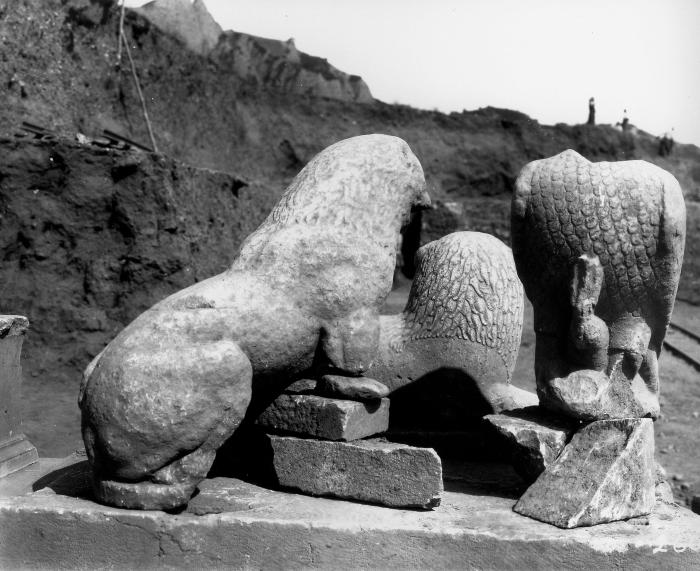Lion Sejant From Nannas Monument
Report 2: Sculpture from Sardis: The Finds through 1975
(1978)
Cat. 235
- Date
- Ca. 500 BC, Late Lydian (Persian)
- Museum
- New York, Metropolitan Museum of Art, 26.59.9
- Museum Inventory No.
- 26.59.9
- Sardis or Museum Inv. No.
- MMA 26.59.9
- Material
- Marble, Stone
- Object Type
- Sculpture
- Sculpture Type
- Animal, Lion
- Site
- Sardis
- Sector
- AT
- Trench
- AT
- Locus
- AT Nannas Monument
- Findspot
- Sardis, 1913. Part of Nannas monument, Artemis Precinct. The piece was probably not reused by Nannas in the 4th C. B.C. but only in the Roman restoration of the precinct. Cf.
Cat. 274 (Figs. 465-466);Sardis R1 , 62, 64, 68.
- Description
- The lion is seated in a frontal position. The tail loops under the hindquarters and over the left haunch. The mane has long wavy locks ending slightly down the back, less deeply cut than Synagogue lions (Cat. 25A, Cat. 25B Figs. 92-101). The style is archaic. Richter (Catalogue of Greek Sculptures, 7) suggests a date of ca. 500 B.C. or a little earlier on the basis of style of modeling and the stylization of the mane.
- Condition
Marble.
Missing almost all of forelegs, parts of hind legs, left side of head, most of plinth. Surface chipped and battered, covered with hard incrustation.
- Dimensions
- H. 0.413; L. 1.04
- Comments
- See Also
- Bibliography
- Published: Sardis I, 125f., ill. 137. Richter, Catalogue Greek Sculptures, no. 6, pl. 9; H.C. Butler, Fourth Campaign, 474; Richter Handbook, 69, Pl. 50 e; Shear, Lion, 128ff., figs. 3, in situ, 4, 9, with comparisons; mentioned in Hanfmann, Rayonnement, 497; von Gall, Felsgraber, 589, fig. 4; Lazzarini and Marconi, New Analysis, 122-124.
- Author
- NHR



